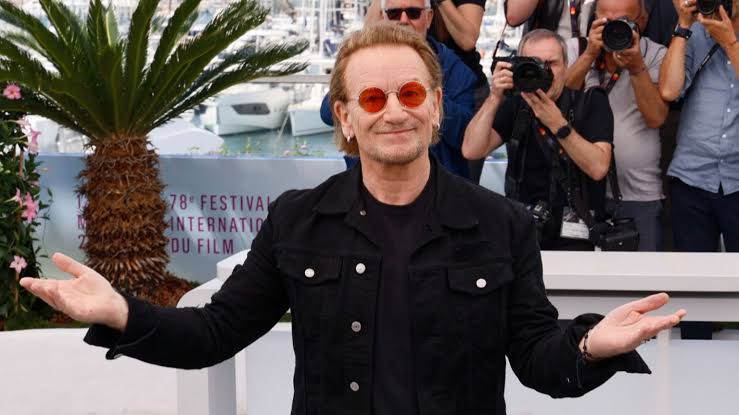Paul David Hewson (Bono) Honored with Long-Awaited Statue in his…
Dublin, Ireland — One of the city’s most iconic sons, Paul David Hewson, better known to the world as Bono, is being immortalized in bronze with a long-awaited statue to honor his extraordinary contributions to music, activism, and Irish culture. The unveiling of the statue, set to take place this summer in Dublin, marks a significant moment in the legacy of the U2 frontman and humanitarian whose impact transcends both national and global boundaries.
A Symbol of Irish Pride
Born in 1960 in the northside suburb of Finglas, Bono rose from humble beginnings to become the lead singer of one of the most successful rock bands in history. U2’s breakthrough in the late 1970s and 1980s placed Dublin on the global musical map, turning Bono into a household name. His poetic lyrics, passionate performances, and commitment to global causes have made him an enduring figure not only in music but also in international diplomacy and activism.
Dublin city officials and local artists have long considered ways to honor Bono, and the decision to commission a statue was met with widespread public enthusiasm. The bronze sculpture, standing over eight feet tall, captures Bono in a classic pose—microphone in hand, head tilted back, mid-song—representing the electrifying energy he brings to the stage.
Designed by Irish Artist Eimear O’Connell
The statue was designed by renowned Irish sculptor Eimear O’Connell, whose work often focuses on capturing the spirit and emotion of her subjects. “This isn’t just a statue of a rock star,” O’Connell explained. “It’s a tribute to a man who has been a voice for Ireland and for many who have no voice of their own.”
The statue will be installed near the iconic Ha’penny Bridge, not far from the Clarence Hotel, which Bono and bandmate The Edge famously purchased and restored in the 1990s. The location serves as a symbolic bridge between Bono’s musical roots and his enduring ties to the city.
Local and Global Reactions
News of the statue has sparked emotional reactions from fans, fellow musicians, and human rights leaders around the globe. Irish President Michael D. Higgins, a long-time supporter of the arts, praised the tribute: “Bono has done much to shape not only the soundscape of modern Ireland but also its conscience. He has brought attention to famine, debt relief, HIV/AIDS, and climate justice in a way few artists ever could.”
U2 bassist Adam Clayton added, “We always saw ourselves as Dubliners first, musicians second. Seeing Bono honored like this in the city that gave us our start is deeply moving.”
Locally, the announcement has reignited memories of U2’s formative years—playing tiny clubs in Dublin, busking on Grafton Street, and rehearsing in makeshift studios. For many, Bono’s story is one of Dublin’s most compelling examples of talent meeting purpose.
More Than Music: A Life of Activism
While Bono’s musical career is legendary—U2 has won 22 Grammy Awards and sold over 170 million records worldwide—it is his activism that has elevated his public image to that of a statesman. He co-founded DATA (Debt, AIDS, Trade, Africa), the ONE Campaign, and (RED), all of which advocate for humanitarian causes across the globe.
Bono has addressed world leaders, met with U.S. presidents and Popes, and pushed for legislation to benefit the world’s poorest nations. His efforts helped secure debt relief for 23 countries and raised millions for AIDS prevention and treatment.
“Bono is a bridge between the worlds of culture and politics,” said former U.S. President Bill Clinton in a statement. “He uses his voice not just to entertain but to empower.”
A Celebration and a Conversation
The unveiling ceremony, scheduled for late August, will include a musical tribute from prominent Irish artists, several of whom cite Bono and U2 as formative influences. There are also plans for a public exhibition showcasing rare photos, memorabilia, and handwritten lyrics from Bono’s personal archive.
Still, the statue has not been without its critics. Some have questioned the decision to honor a living figure, while others argue that more community-driven initiatives could have received priority. But supporters counter that Bono’s legacy is already firmly established and deserves recognition while he can still appreciate the honor.
“It’s not just a statue of Bono,” said Dublin City Councilor Aisling Byrne. “It’s a tribute to Irish creativity, resilience, and global influence. Bono is a symbol of what Dublin can produce when art and conscience come together.”
Legacy in Stone
For Bono, the tribute is both humbling and surreal. “To see yourself cast in bronze, to become part of the city’s streetscape—that’s not something a boy from Cedarwood Road ever dreams of,” he said in a statement. “I’m honored, a little embarrassed, and mostly grateful.”
As the statue takes its place in the heart of Dublin, it becomes more than a monument to one man—it becomes a celebration of a generation, a genre, and a journey. Bono’s voice helped define a sound, and his conscience helped move the world. The statue now stands as a permanent reminder that one voice—when amplified with passion and purpose—can echo across nations.

